
AT its last Session in 1959 the Conference of FAO, the governing body of the agency, decided to include wildlife management among the regular activities of the Organization. More recently, FAO's newest Regional Forestry Commission, the African Forestry Commission, meeting in Nigeria in November 1960, decided to Set up a special working party charged with developing an action program relating to a specific number of aspects of wildlife conservation and management in the region. In the meantime, FAO will be collaborating in the special Africa project on wildlife of the International Union for the Conservation of Nature and Natural Resources (IUCN), in providing a wildlife specialist for the Congo, and also seconding a member of its staff to serve as Secretary-General of IUCN.
Few would disagree that there is a duty to preserve certain portions of Africa, first, to save some of its wealth of wild animal life, secondly, to protect wild vegetation and places of beauty and interest and, thirdly, to maintain an attraction for tourists.
There is a general acceptance of the alarming conclusion that wild animals are disappearing from the face of Africa at such a rate that within a short span of years they will be beyond the point of no return.
There is no doubt whatever that many parts of Africa have already been denuded of their wild animal populations. Even in living memory, wild animals have gone from South Africa and can now survive only in the few remaining sanctuaries. This is true also of many parts of Central and East Africa.
Explorers and hunters traveling through Equatorial Africa during the last century described the teeming herds of animals which were seen, and yet today many parts of those same countries have no wild animal life whatever. Kenya, which was always regarded as the paradise of big game, has also suffered from this general decline in numbers. This tragic story can be repeated throughout the length and breadth of Africa.
The sanctuaries included in the system of national parks and reserves throughout Africa are hopelessly inadequate to preserve all the species which used to roam the face of this great continent. Africa is a harsh master and its animals are subjected to all kinds of calamities, including epizootic diseases, floods, plagues and droughts. Should a species in one area be destroyed by one of these misfortunes then there is no reservoir from which to draw replenishment. In the old days when animals were exterminated in a particular zone by some calamity, they were not similarly affected in other areas, and they could soon replace their breeding stocks. This substantiates the argument for having as many and as large national parks as possible.
Admittedly, every Government in Africa has the difficult task of zoning its land. Some of it must be used for agriculture, some for livestock, some for settlements, some for towns, and some for other forms of development, but in this scheme of things there must be a place for the wild animal and for wild vegetation, Wild animal habitats, catchment areas and forested mountains must be recognized as a form of land use, and a most important feature of a wise land-use policy.
Courtesy: H. G. Winkelmann
FIGURE 2. - A hostel for single men working at a state sawmill in New Zealand.
Courtesy: New Zealand Forest Service